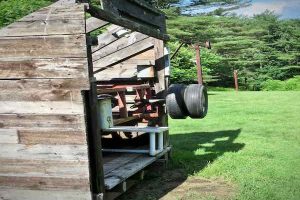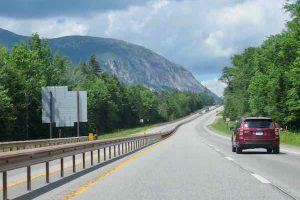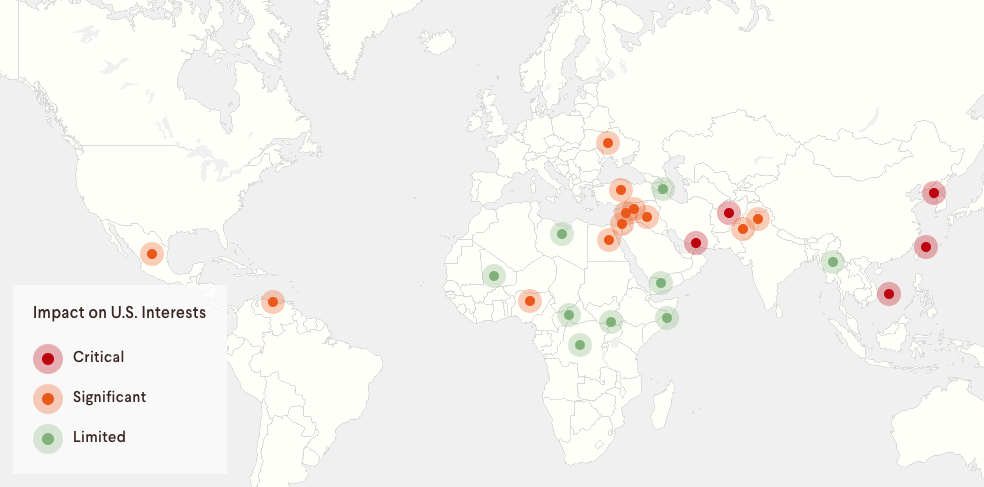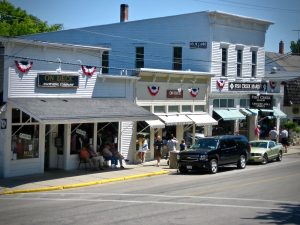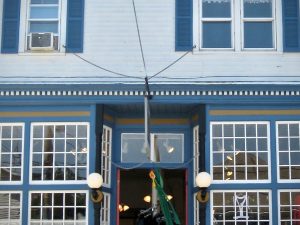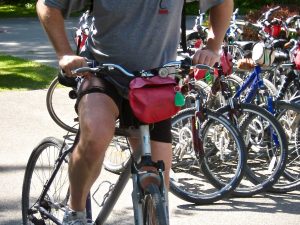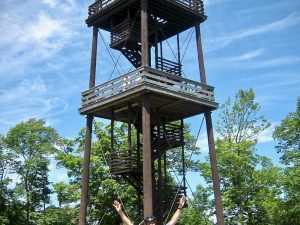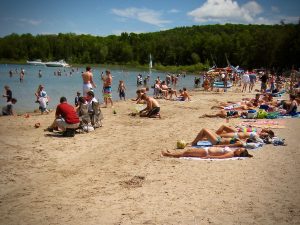Where’s the Funny? Newsletter
Volume 3: January 2020
ON THE ROAD: Never be afraid to ask questions
My mom never met a stranger. And two of her four children – the left handed ones, numbers two and four – are cut from the same cloth. My sister and I never met an usher or a hotel receptionist or street vendor or park ranger (or homeless person) we couldn’t chat up.
Now, in my sister’s case, it was about making new friends, as she unloaded deeply personal details on unsuspecting innocents. I, on the other hand, as a journalist, had been trained to cold call absolute strangers (and make them feel at ease) for years. My job, as a professional, was to extract information – not give it up. The result is a man who is not afraid to ask directions.
To the layperson travel companion, this can be exasperating. “Where’s Steve? Who is he talking to now? Why is he talking to that person!” It can also be quite rewarding.
Once, in the south of France, a local told me that the tiny hilltop village of Gourdon was not to be missed. It was not on our route, and one of my three travel companions was adamant that we NOT go there. “It’s a waste of time. It’s NOT in the guide book. Guide books are written by experts. So, if it’s not in the book, why should we go there?” he said, as the veins in his neck began to bulge. “DO NOT GO THERE!”
One advantage to being the person behind the rental car wheel is that you have total control of where the vehicle goes. So away we went on our little detour to Gourdon, which rewarded all of us – even the naysayer – with incredible panoramic views (and ice cream).
On another occasion, at the Hedon Spa & Hotel in Pärnu, Estonia, I was asked, “How on earth did you find this place?” The simple answer was, I had asked a couple of assistant managers at My City Hotel in Tallinn. These were the same folks who recommended a wonderful little seaside restaurant, NOA, a short cab ride away.
Make no mistake, it’s the people who actually live in a place – not the guidebook writers – who are the real experts. So never, EVER be afraid to ask questions. In the words of Kruiil, from The Mandalorian: “I have spoken.”
QUOTE:
“Travel is fatal to prejudice, bigotry, and narrow-mindedness, and many of our people need it sorely on these accounts. Broad, wholesome, charitable views of men and things cannot be acquired by vegetating in one little corner of the earth all one’s lifetime.”
– Mark Twain, The Innocents Abroad (1869)
WTF? NEWSLETTER
WHERE'S THE FUNNY? In Plymouth, New Hampshire
There is something quite satisfying about catching up with old friends on a road trip, which is exactly what I did last June on my drive from Chicago to Boston to Quebec City and back.
About two hours northwest of Beantown is the lovely New Hampshire hamlet of Plymouth, population 6,752 (2017). This quaint New England town, incorporated in 1763, is home to Plymouth State University, where my friends have a son on the football team. It’s also where they bought the Frontenac Ski Lodge, a former ski camp that dates back to about 1935.
There’s no skiing here anymore, but if you have a large group (up to 28) and don’t mind affordable “rustic” comfort (four doubles and nine singles in five bedrooms on the first floor; two dorm-style bunk rooms with nine singles, one double, on the second), then this is the perfect place for your weekend wedding, reunion, bachelor party or work retreat.
The best things about re-connecting with friends in unfamiliar places are: 1) It’s free; and, 2) They know stuff – really cool stuff. Like, in Plymouth, there was a sporting goods company called Draper & Maynard, which in the 1920s made baseball gloves, mits and bats for up to 90 percent of the pros, including Babe Ruth, who had visited the business in 1916 after helping the Boston Red Sox win the World Series. The Draper & Maynard collection, which includes a photo of The Babe stitching a baseball, is on display at Plymouth State University.
From Plymouth, the Lake Region Conservatory Trust manages miles of trails, many with waterfalls. You can also tube down the Pemi River. We opted for a drive past Holderness to hike from the Armstrong Natural Area to Rattlesnake Mountain and a scenic overlook of Squam Lake, where they filmed On Golden Pond. The scenery is totally New England summer camp, and I could imagine a Camp North Star (Meatballs) or Camp Crystal Lake (Friday the 13th) around every bend.
Did you know that New Hampshire has 48 peaks over 4,000 feet, while Vermont only has five? Hiking is so popular around here that the authorities have to rope off miles of highway shoulder in the summer when the trailhead parking lots overflow. Other fascinating facts near Plymouth include:
- Sugar Hill was the home to the first U.S. ski school (1929), which may have had an influence on world champion alpine ski racer Bode Miller, who grew up in nearby Easton and Franconia. Most importantly, Sugar Hill also is where we had brunch at Polly’s Pancake Parlor, which has been filling folk with calories since 1938.
- Franconia also is home to The Frost Place, a museum in the former homestead of poet Robert Frost, as well as the Garnett Hill mail order company. Franconia Notch was the location of the Old Man of the Mountain epic rock formation, which came crashing down in 2003.
- For a good little freak show for the kiddies, you also can stop by Lincoln, where Clark’s Bears have entertained (humanely, I’m sure) the masses since 1928. Hopefully, it’s not the same bear. Here, you also can hop aboard the White Mountain Central Railroad for a 2.5-mile, 25-minute ride, which culminates with a horrifying attack from “The Wolfman.”
Another fun fact about New Hampshire, according to local inhabitants, is that there are several towns with “foreign” names that are pronounced differently than their counterparts, due to the anti-German et al sentiment during the World Wars. So, Berlin becomes BURR-lin and Tripoli goes by Trip-o-LIE and Lebanon is pronounced LEB–uh-nin.
This all makes perfect sense in a place where the New England state demonyms include Massholes and Vermonsters, New Hampshits, Mainiacs and (gulp) Connecticunts.
It’s enough to make you want to drive to Quebec City! Which after a hug and a kiss, is exactly what I did.
READER POLL:
LISTICLE: 'TIS THE QUEEN CITIES SEASON
5 holiday activities in Charlotte, North Carolina:
For the first time in years, my Christmas celebration took place outside of Cincinnati in yet another Queen City (there are about 30 in the United States): Charlotte, North Carolina. This is where my sister and her New England-born husband have lived for close to 30 years. Here’s a sample of where residents there celebrate the holidays:
- Charlotte Christmas Village and Christkindlmarkt (Nov. 20 – Dec. 24, 2019): This Uptown Charlotte holiday event features a German/Austrian-themed market, Santa and all the Glühwein you can drink. The best part? Free admission!
- Self-guided Holiday Walk: This 1.9 mile tour of Uptown Charlotte includes a bevy of Christmas-themed photo ops, starting with the Mint Museum Uptown (there are two Mint Museum locations), through Thomas Polk Park, The Square and Founders Hall, where the Leonard Bearstein Symphony Orchestra of terrifying animatronic bears performs on the hour.
- Holidays at the Garden (Nov. 29, 2019 – Jan. 5, 2020) at the Daniel Stowe Botanical Garden: Take a walk through the Mile of a Million Lights, which is much more doable than the Million Miles of Lights.
- U.S. National Whitewater Center: Take a half mile stroll through an immersive outdoor art exhibit called “Lights” or ice skate on a 17,000 square foot rink. The USNWC has been open since 2006, with only one brain-eating amoeba incident on record.
- Christmas Town USA (Dec. 2 – Dec. 26, 2019): Take a 30-minute drive to McAdenville, North Carolina, where you will find the second of the USA Today 10 Best Public Holiday Light Displays in the United States. Make a reservation for dinner at nearby Nellie’s Southern Kitchen in historic Belmont. It’s owned by the parents of the Jonas Brothers. We didn’t have a reservation and the wait was 1.5 hours, so we ended up at The String Bean, a Southern bistro and market just up the street. For what it’s worth, Bentleyville, near Duluth, Minnesota, tops the list. But who has relatives in Duluth?
- BONUS ROUND: There is a cute, very walkable little street street called Hillside in the Myers Park neighborhood where the houses are all decked out for the holidays. Stringing gigantic light balls way, way up in the old oak trees seems to be the thing to do.
5 holiday activities in Cincinnati, Ohio
From 1968 until we sold our family house in 2019, the Village of Terrace Park was the place I called home. When it comes to the holidays in Cincinnati, names and locations may change, but the core festivities remain the same. Use this to help plan your next holiday season:
- PNC Festival of Lights (Nov. 16, 2019 – Jan. 4, 2020) at the Cincinnati Zoo & Botanical Gardens: It can get a little crowded under a canopy of lights but who doesn’t want to say hello to Fiona, the resident rock star hippo?
- Holiday Junction featuring the Duke Energy Trains (Nov. 8, 2019 – Jan. 5, 2020) at the Cincinnati Museum Center at Union Terminal: With more than 300 rail cars, 60 engines and 1,000 feet of track, this Baltimore & Ohio (B&O) Railroad display was created in 1935 as a training tool. In 1946, it was given to the Cincinnati Gas & Electric (CG&E) Company, where it was featured during the holidays in their downtown lobby. In 2011, the trains moved to Union Terminal, a Cincinnati Art Deco architectural icon that opened as – you guessed it, a train station – in 1933.
- Zinzinnati Holiday Show (Nov. 9, 2019 – Jan. 5, 2020), Family Nights Krohn by Candlelight and the live animal Crib of the Nativity at the Krohn Conservatory: This bastion of butterflies sits in Eden Park, home of the Cincinnati Art Museum and the Playhouse in the Park. During the holidays, it’s packed with poinsettias. And just up the hill off Eden Park Drive at Twin Lakes is a grand overlook of downtown and the Ohio River.
- Charles Dickens’ classic “A Christmas Carol” (Nov. 26 – Dec. 31, 2019) at Cincinnati Playhouse in the Park: Since 1960, this venue in Eden Park has offered the best in live theater. My favorite show was UC Bearcats football player and actor David Canary (e.g. Bonanza, All My Children etc.) in “Man from La Mancha.”
- UC Health Ice Rink presented by Fifth Third Bank at Fountain Square (Nov. 2, 2019 – Feb. 2, 2020): In the 1980s and 1990s, the KKK used to anger locals by raising a cross at Fountain Square during the holidays. Thankfully, that practice has stopped. Now it’s just the over branding of ice rinks that’s offensive, but what would you expect in the home of household brand king Procter & Gamble?
- BONUS ROUND: From the mid-1950s to the early 1980s, there used to be more than 130 mechanized holiday elves in the window displays of the flagship Shillito’s department store at Seventh and Race streets downtown. With the takeover by Lazarus in 1983, the elves disappeared. Enter Bill Spinnenweber, whose family owns the Mariemont Inn. His resurrection of the elves display is a great holiday story.
IN PRACTICUM
RENTAL CAR INSURANCE 101: Know your credit card benefits
You absolutely must have a sense of humor to suffer through any encounter with a rental car agent, whose sole mission in life is: 1) To not give you the car you requested in your reservation; and, 2) To upgrade (aka upsell) you to an Aston Martin DBS Superleggera, which by the way will get you 14 MPG in any city – not that it matters on a machine that starts at $304,000 (NOTE: Why not start at $299,999?).
Personally, I have had only two encounters with rental car insurance – which I 100 percent decline at the counter, whether I’m in the USA or abroad – in the past 30 years. My VW Golf was hit while parked at a supermarket in Palmas, the state capital of Tocantins in Brasil. I was not at fault and not required to pay for the new taillight. And, in Germany, upon check-in a dubious, dour and definitely former Eastern Bloc, Berlin-based Sixt agent claimed there were scratches on my right, rear hubcap – micro abrasions invisible to the human eye – that would cost a whopping $1,100 to repair. I took a bunch of photos, then flew home to Chicago, where I fought the charge (successfully) over the phone, but it did take a few months to resolve.
In any case, I’m a bit of a planner when it comes to travel. Let’s just say, I like to know my options. When it comes to credit card car rental coverage, here are some basic steps you can take to make sure you don’t get screwed when you refuse the Collision Damage Waiver or more:
- Call your insurance agent: In my case, that’s State Farm. And if I am renting a car in the United States for U.S. travel only, my coverage is sufficient. Outside of the United States, there are few countries where I would not be covered. Ask your agent.
- Call your travel credit card provider: Most cards have their coverage spelled out online. Print it out and read it, or call customer service, to be perfectly clear.
- Know the difference between primary and secondary coverage. Some cards will defer to your auto insurance provider first, then only reimburse your deductible, for example.
- Know how many days are covered: Some cards cover you for 15 days; some for 30 or 31. I don’t know if any card company will provide coverage beyond that.
- Know what you need to do to cover a second driver.
- Know how to file a claim.
And if you are looking for a travel credit card, do your research online first. To help, I’ve included a few links to some well-known blogs (who are compensated if you click on the links) in the sidebar.
AMERICAN EXPRESS
CAPITAL ONE
OVERVIEW: How Rental Car Insurance on a Credit Card Works
- EXAMPLE: Capital One Visa Platinum (PDF)
CHASE
OVERVIEW: Auto rental collision damage waiver
- EXAMPLE: Chase Sapphire Visa Signature (PDF)
CITI
According to several reputable blogs, Citibank on September 22, 2019, dramatically reduced or dropped a ton of travel benefits (e.g. car rental coverage) on many of its credit cards. If you plan to use a Citibank card, call before you travel.
A FEW (COMPENSATED) BLOGS:
QUICK SPINS
LOOKING FOR TROUBLE: Where to find conflict across the globe
If war tourism is your thing – or, more likely, if it’s NOT your thing – then it might be best to check out where the battles rage before you book that trip to Aden, Yemen.
The New Humanitarian publishes an interactive map of all the major conflicts across the globe. For more of a political spin on what impacts U.S. interests, check out the Global Conflict Tracker from the Council on Foreign Relations.
Depending on who’s doing the research, there are only two or three hot spots (not including parts of Chicago) in the entire Americas: Mexico, where drug cartels are in a turf war; Venezuela, where 2019 inflation hit 10,000,000 percent (!); and Colombia, which despite the peace agreement with FARC in 2016 still has a slight guerilla / paramilitary / drug kingpin problem in certain areas – although this didn’t stop a cumbia crazed friend of mine from visiting Bogotá and Cartagena a half dozen times this past year without incident.
My advice? If you happen to see TV war correspondents Holly Williams (CBS), Peter Bergen (CNN) or Richard Engel (NBC) at your airport gate, you may want to rebook. If you see one of them at your hotel, ask for a room on the ground floor – but it’s probably already too late.
STROOPWAFEL: Thank you, sir – may I have another? And another!
Like many flu-bitten U.S. Americans, I was feeling way under the weather on my return United Airlines flight from Christmas in Charlotte, so I did a very un-Steve like thing and splurged for the $69 upgrade to First Class.
Now, normally, on this Embraer EMB 175 jet, that would be a total waste of money. It’s quite a comfortable two-hour ride. And there are only 20 rows (76 seats) on the whole plane, with four in First Class (1-2 configuration), four in United Economy Plus (2-2) and 12 in United Economy (2-2). (NOTE: Please don’t ask me why there are no rows 5, 6, 13 or 14 on this plane – that’s a subject for another day.)
They may be only inches away, but the low lifes in economy class only get pretzels and a drink. Meanwhile, the swells in first class get to choose from a basket overflowing with treats – including my absolute favorite, the Daelmans stroopwafel. (NOTE: Buy them online!)
I rolled my glossy, bloodshot eyes up to the flight attendant, who had just finished telling us to “hug your neighbors” on the loudspeaker, and asked, “May I please have two?” She gave me four! And a drink. AND, a banana! It was spectacular.
Now, for a “melty caramel treat,” the stroopwafel geniuses suggest that I “rest the stroopfwafel on top of a steaming cup of coffee or tea for about a minute.” Are they kidding? Two were gone in 30 seconds, while the other two were jammed into my shirt pocket for later. And that, my friends, was the best $69 I will ever spend.
VANILLA PRICE: After saffron, it's the world's second most expensive spice
A tiny paragraph in Bon Appétit magazine recently caught my attention: That the cost of vanilla beans in 2018 was more than $600 per kilo (more than silver!) and that almost 80 percent of the product comes from Madagascar. No wonder Graeter’s ice cream is so expensive!
Now, at up to $5,000 per pound, saffron is the most expensive spice in the world. And that makes some sense, as it’s super labor intensive to pick three delicate stigmas from the Crocus sativus flower.
So why is the vanilla bean, which comes from a type of orchid, so expensive? According to a story in the Financial Times, vanilla was first cultivated in Mexico. In the early 1800s, French colonists took the plants to the Indian Ocean islands of Réunion and Mauritius, but the crops failed because there were no bees to pollinate the flowers.
Enter Edmond Albius (1829-1880), a 12-year-old slave on Réunion. He invented a more efficient albeit very manual method of hand pollination that is still in use today. The plants ultimately were relocated to Madagascar, which has the perfect climate AND a huge supply of cheap labor. And that’s why the island remains the primary source of vanilla beans today.
Cheap labor often means child labor, so it’s interesting to see how far a huge company like Nestle will go to assure a clean vanilla supply chain. Just something to think about when you dip into your next iced vanilla latte or other assortment of vanilla-based treats. And, if you’re really interested, here’s a 2018 list of goods made with child labor (PDF) from the U.S. Department of Labor.
A FEW OF MY FAVORITE THINGS: Fish Creek, Wisconsin
QUESTIONS OR COMMENTS?
First, thank you for reading this newsletter. If you have any questions about anything that appears here, please do not hesitate to contact me directly via email at: hello@wheresthefunny.blog.
PREVIOUS NEWSLETTERS
- Where’s the Funny? Volume 1 (November 2019)
- Where’s the Funny? Volume 2 (December 2019)


